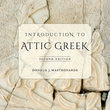|
Note on ω: You may also hear omega pronounced like long o in English go.
Note on ῳ: This is a so-called long diphthong, because it is a combination of long vowel ω and ι. The recommended pronunciation reflects postclassical practice. In the fifth century this was a true diphthong, but the iota part of the sound weakened during the fourth century to a glide and then disappeared. Click on the image of inscription ΟΙ to hear an approximation of the original diphthong and the weakened diphthong.
The iota in the three long diphthongs is presented in most texts as a subscript under the long vowel (iota subscript: ᾳ, ῃ, ῳ), a convention developed in medieval Greek manuscripts and imitated in the typographic conventions of Greek since the Renaissance. The earlier practice was to write iota in normal position at normal size after the vowel (iota adscript: αι, ηι, ωι). (For a short time around the 12th century some scribes wrote a slightly smaller iota just to the right of the vowel and slightly lowered.) In some modern editions you will see iota adscript.
|  Pronunciation Guide
Pronunciation Guide
